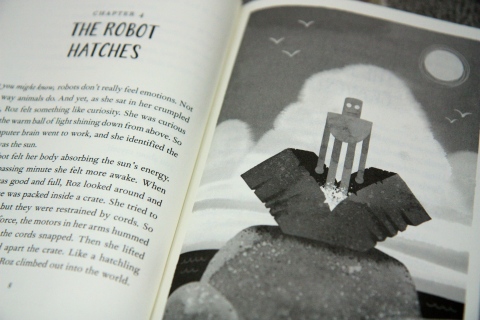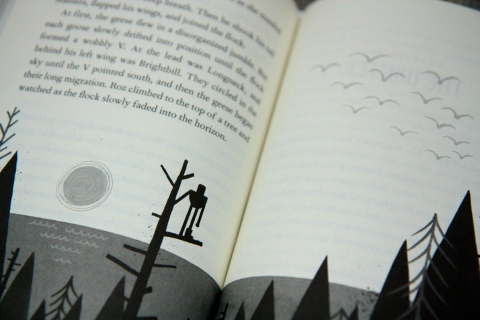Survival Skills
February 16, 2017 § 6 Comments
 When my daughter was five, we were sitting at the dinner table discussing our days. “I almost forgot,” Emily said. “The craziest thing happened to me today!”
When my daughter was five, we were sitting at the dinner table discussing our days. “I almost forgot,” Emily said. “The craziest thing happened to me today!”
“Oh yeah? What was that?” we all asked.
Emily leaned in conspiratorially, as if getting ready to impart significant information. “I didn’t have a single sip of water all day. BUT I STILL SURVIVED! Can you believe it?”
It was all I could do to keep from bursting out laughing, not wanting to diminish her stone-sober revelation. And yet, I haven’t stopped thinking about her words since. Clearly, whether at school or from a book or in conversation, Emily had absorbed something about “what every living creature needs to survive.” But she had only internalized half the story. What must it be like to make sense of the world through bits and pieces, to rarely grasp the full picture, to live your life in a perpetual loop of uncertainty and astonishment (as if you could accidentally “off” yourself at any moment)?
This, I realized, is what it’s like to be a child.
In his first foray into chapter books, Peter Brown (already beloved in our house for this, this, and this) perfectly captures this same befuddlement, anxiety, and marveling with which young eyes view the world. Only, in the case of The Wild Robot (Ages 8-12, younger if reading aloud), the innocent protagonist is not a child but an erect, talking robot named Roz, who is inadvertently activated on a wild, remote island by some curious sea otters, after they discover her crate washed up from a shipwrecked container ship. Roz—short for ROZZUM Unit 7134—has no understanding of anything prior to the moment she opens her eyes, nor whether she has a purpose. She knows only that she has been designed to “move, communicate, and learn” and that she has been programmed with Survival Instincts which “made her want to avoid danger and take care of herself so she could continue functioning properly.”
As our robot begins to navigate the diverse terrains of the island—rocky shore, craggy mountain peaks, pinecone-blanketed forest—she meets with a variety of physical upsets. But it is during her encounters with the wild inhabitants of the island—particularly the ferocious bears—that she begins to understand the magnitude of the challenge before her: in order to survive, she must adapt like the creatures around her. She must become wild. She must climb over rocks like the crab; she must seek out higher ground at the threat of rain like the deer; she must camouflage herself like the stick bug. Like a committed anthropologist, she must observe their behavior, and she must learn their language.
The Wild Robot has been recommended by many—owing to its short, staccato-like chapters, its frequent illustrations done by Brown himself, and its plethora of animal characters—as a book for young independent readers. But it would be a mistake to take this as proof that the story is simple, that it doesn’t pose some fascinating questions or offer some complicated—at times somber—answers.
If you are going to share this book with elementary children, I would argue that The Wild Robot works best, certainly most powerfully, as a read-aloud. I say this not just because robot voices are fun to do. Not just because there are a multitude of animals with their own personalities (read: more fun voices). Not just because of the elegance of the prose, the understated and surprising humor, or the way in which the story beautifully crescendos from a quiet beginning to a nail-biting conclusion.
I say this because, when all is said and done, the story delivers a profound message about what lies at the heart of survival. It’s a message that’s vitally important for the times in which we are living, and a message that can be strengthened when we choose to witness it alongside our children.
It’s a message of community.
As artificial intelligence, Roz is not designed to feel emotions: her initial drive to observe and befriend different animals stems, not from feelings of loneliness or empathy, but from a practical, learned understanding that she needs allies in order to survive. Her offers to help certain animals—even her adjustment to a more cheerful voice (she learns the art of performance from watching an opossum)—initially come from a place of selfishness: I’ll rub your back to increase the chances that you’ll rub mine. Roz removes a porcupine’s quills from a fox; the fox in turn helps spread the word that Roz is not a “monster.” Roz helps fell trees for the beavers; they, in turn, show her how to build a shelter.
It may be selfishly motivated, but what a wonderful lesson for our children: unsolicited helpfulness as the first step toward making friends.
Because Roz is programmed to learn, she quickly understands that individual alliances are only part of the larger puzzle to survival. She must cast herself at the center of an interdependent community. She builds a garden, not because she has any use for food, but because it attracts the squirrels and deer and birds to her front door each day. During the coldest, snowiest winter the island has ever seen, Roz builds forts with fireplaces to keep her friends from freezing (she insists they agree to a temporary predator-prey truce). Roz doesn’t simply coax the animals out of their fear of the shiny metallic newcomer; she secures their loyalty and protection—something which turns out to be even more important than anyone anticipates before the story ends.
And here’s where the magic happens. The more Roz seeks to understand the motivations of others, the more she begins to experience—dare we call it feel?—as much a responsibility to her fellow animals as they feel to her. Where one act of helpfulness ends and another begins becomes brilliantly, perfectly blurred. Roz has enfolded herself completely into the ecosystem to which she was once an outsider. In her straightforward wisdom:
‘…I used to be shiny, like the surface of the pond. I used to stand straighter than a tree trunk. I used to speak a different language. I have not grown bigger, but I have changed very much.’
Nowhere is Roz’s rising sense of responsibility to her fellow creatures more touchingly conveyed than in her care for a young gosling, whose family she inadvertently destroys when she causes a mudslide. Because Roz sees the world in terms of problems to be solved, she is determined to save the remaining egg by bringing it to another family of geese. And yet, the orphaned gosling has another idea in mind—that is, once he hatches from the egg and imprints on the robot. “You’ll have to act like his mother if you want him to survive,” Roz is advised by the leader of the geese. And yet, once again, what starts as an act—learning to build a fire to warm Brightbill’s feathers, rocking the gosling to sleep—is quickly replaced by a mutual fondness for one she calls “son.”
As is fitting for a story about the natural world, there is struggle, violence, and death alongside joy, beauty, and survival. As our narrator gently reminds us, “the wilderness really can be ugly sometimes.” And yet, when frozen corpses give way to springtime blossoms, we are reminded that we cannot have one without the other. Again, interdependence emerges as a central theme.
In an ending that is anything but simple—haunting, open-ended, and hopeful—Roz, too, must play her part in upholding the delicate balance of the island. I don’t dare give anything away, but I will relate this anecdote. When we were halfway through the book, my son started reading ahead after I left his room each night (always the sign of a Big Win). One night, he came down the stairs to find me in the living room. “I finished,” he announced. “And?” I asked. “It’s…really…interesting. It’s…really…amazing. You’ll see when we read it tomorrow.” And I did see. It’s an ending that might raise more questions than it answers, but it also leaves us with a certainty that we are stronger when we are looking out for one another.
It puts me in mind of something Mother Theresa said—and which a friend shared recently on her Facebook page in response to the unrest in our country right now: “If we have no peace, it is because we have forgotten we belong to each other.”
If we wish to help our children someday understand what Mother Theresa meant, if we wish to raise them in a world that moves toward inclusiveness, we can start by reading them The Wild Robot.
—
Did you enjoy this post? Make sure you don’t miss any others! Enter your email on the right hand side of my homepage, and you’ll receive a new post in your inbox each week.
Book published by Little, Brown. All opinions are my own. Amazon.com affiliate links are above, although I prefer that we all shop local when we can!
Related
Tagged: animals, anthropology, chapter books for 9-12 year olds, children's books with bears, community, favorite illustrators, friendship in children's stories, mothers in children's books, nature, non-traditional families in children's literature, Peter Brown, read-aloud chapter books, robots, science-fiction for children, seasons, survival in the wilderness






Melissa, this is such an insightful post. I so agree with your thoughts and description of Wild Robot. I always marvel at your beautiful writing! Susan
Thank you so much, Susan! I really appreciate your nice words and am so glad you agree that Wild Robot is a gem.
My 4th grader just inhaled this book in two hours and loved it. He, then, highly recommended that I also read it. Now he’s asking for more from this author.
Peter Brown definitely needs to write more middle-grade fiction! 🙂 So glad your son loved it.
[…] Survival and Wildness with Peter Brown […]
[…] Not included are titles I blogged about earlier in the year—gems like The Inquisitor’s Tale, The Wild Robot, and See You in the Cosmos, which would make excellent additions to this list. Also not included […]